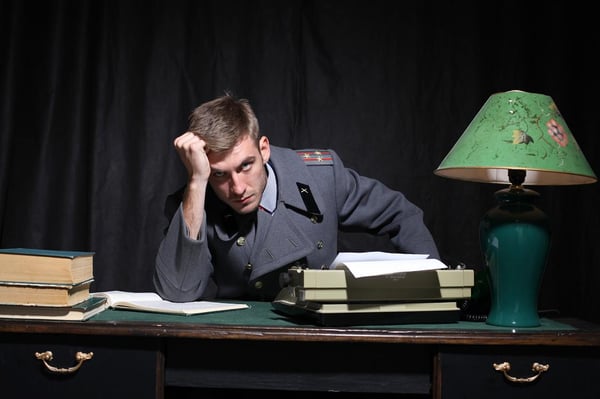Published on
Working to Support the Military Student in Higher Education

With Amy Sherman | Associate Vice President for Policy and Strategic Alliances, CAEL
The following interview is with Holly Moore, the Executive Dean of South Seattle Community College’s Georgetown Campus, and Amy Sherman, the Associate Vice President for Policy and Strategic Alliances at CAEL. Moore will be speaking on success strategies for military students at the National Council for Workforce Education conference. In this interview, Moore and Sherman discuss some of the challenges facing military and veteran students, and successful strategies that help move this demographic of non-traditional learners toward completion.
1. What are some of the biggest challenges facing veteran and active military students when they return to higher education?
Holly Moore: One of the things that I see as a major challenge is the contrast that exists between military and civilian life and the student and—in our case we’re doing a lot of apprenticeship training—so the apprentice role. Allowing enough time to make those transitions and helping guide the individual through those transitions is going to be very important but it’s also very challenging because colleges aren’t equipped to deal with much more than the educational realm. We have to re-tool ourselves to be better at that.
Amy Sherman: At CAEL we work with multiple institutions and systems and one of the pieces we see that’s often missing is that guidance and navigation so that you can make a successful transition and make good choices about your educational pursuits.
That’s particularly important when veterans have time limits on their education benefits that they make smart choices and don’t waste their time. We also see issues just in terms of managing time constraints. Veterans are often in families, they have responsibilities. So just like any non-traditional learner, they’re juggling a lot. They need flexibility and support.
Finally, not all but many so have physical issues or psychological issues from their service that they’re still having to deal with and need support.
HM: Those two things bring up some things in my mind that are important challenges. This is creating a new family dynamic. The veterans have been, in most cases, away from their family. Now they’re going to have to renegotiate a new role where they’re very connected and very involved with their family, so that’s different. …
AS: I think what Holly is saying is right on. There is a real structure when you’re in the service. You know what you’re doing almost every minute of the day, you have a schedule and you’re not even choosing your schedule. All of a sudden, you’re bombarded with so many choices and so much need to figure out—not only this moment but the next one—it can be really overwhelming. That’s why I think that it’s not just advising, but it’s important for faculty to understand and for staff to understand that this can be a big experience. That doesn’t mean that veterans can’t manage it and be very successful in doing it, but that’s why it’s important when you’re thinking about this to think about what kind of supports are there for veteran military students?
HM: It’s dealing with coping skills, stress management, techniques for reducing reactions to a trauma-based experience, all of those things need to be at the ready and, at colleges, we need to at least partner with agencies that can provide these supports on an ongoing basis.
AS: There was a study done by the Tillman Foundation that did a comparison on retention rate for certain veterans who went to institutions that they identified as having really solid military supports… versus those that were in the general population. They found the average retention rate for student vets—this is in 2010-2011 school year—that came from schools that had solid supports were 94 percent, compared to a national average of 65.7 percent.
These supports are not small, they’re really about success for the student veteran and making sure that the public investment in getting them education and training is a meaningful investment and really has the return that we’re looking for.
2. How do these challenges typically impact this student group’s probability for degree completion?
HM: I think this is going to be kind of interesting as we look at this in the long term, as we see vets returning from the Middle East and other places. My initial experience would be to say that I think they have a very strong probability of completion.
I would venture a guess that we’re going to see higher completions in these cohorts than we have in previous. For example, we have a 98 percent completion rate over three years and we have trained nearly 400 veterans. … This is an apprenticeship program, and our apprenticeships range in length from two years to five years. We have a 90 percent retention in jobs over two years, that’s after they’ve completed their apprenticeship and they enter into a job.
That says that there’s a really high probability. But the reason that there is that kind of probability is because those issues, those challenges, are being addressed in an ongoing way. Not just by the college, but by college partners. For example, we’re in a partnership with King County, which is the country that has the city of Seattle, so it’s the largest county in the state of Washington. And in that partnership with King County, they provide what we’re going to call “the wrap-around services”. They’re providing ongoing coping skills, stress management, dealing with family dynamics, dealing with time management and a re-orientation to the civilian-student-apprentice environment, which is really important because they’re not always things that the college can provide. The college provides veteran support groups, we have a veterans lounge, we have a veterans club, we have a lot of things going on to focus the attention and support and to create a network for veterans. But it’s our partners that make the programs successful. … Those folks are providing us with the support that makes that student successful.
AS: I think that it gets into, you know, when you think about Principles of Excellence or supporting the student veteran, we have to be reaching out to the various stakeholders. We can’t be just focusing on higher education, but we need to be engaging all the stakeholders; employers, community and higher education and public agencies so that we make sure we’re thinking of the bigger picture in terms of support systems and looking at this in terms of a system. I think one of the reasons why the apprenticeship model is so appealing… it really gives recognition for the learning that you have already gained through the military life. …
One of the reasons you see this high completion rate, in addition to support services, is the apprenticeship program gives a sense of, “I am in the real world, I am learning things that are really going to make a difference in my career.” There’s a feeling of accomplishment and already thinking about your future helps the transition.
Those are really important factors that make apprenticeship a really appealing strategy for many student veterans.
HM: I just want to add a couple of things. One is as colleges have gotten more focused on completion and less on, “Just get them in the door,” which I think is what we were—as colleges we really prided ourselves on that open-door policy, “Get them in the door and it will come”—now as institutions, we’re focused on making sure that the entry through the door is a successful entry and that we see the students through to completion. We have a lot of advising principles in place, new ways of making sure that students connect in that first, initial quarter and that students jump into their subject matter as quickly as possible. We know that if we put people in English and Math and we don’t connect that with where they want to be with their career goal, they are less likely to complete. This is especially true of veterans who have been in the world of work, even if it is within a military structure. They have been in the world of work and they are very goal-oriented and completion-directed. We have had to change our strategies to look at completion as being one of the most important things that we do as a college.
3. What are a few strategies you would suggest for institutions looking to ameliorate some of the challenges veteran and active military students face?
AS: One thing that I think is really common is to look at your policies and see where you may be, as an institution, creating real problems. I’ll give you an example. Policies not to charge late fees for tuition payments because often, it’s because of some delay in [military or veteran students’] benefits. Making those exceptions, giving them priority registration, making sure if they’re called off, they can come back easily. Some of this is just really thinking, “What can we do to make this an easier existence for them?”
Another piece that we stress as a principle, having a single point of contact so they know where they can go, and if their person doesn’t know the answer they will navigate [the student] through to get the answer. This is really important.
HM: That is a very important factor. Making sure it’s clear who to go to, helping the student and the veteran navigate the system. Because it’s a very foreign system.
I wanted to add a couple of things. One of the things that has been really important is that we as advisors and administrators in colleges stay abreast of what’s happening. Right now, the military is going through Joint Services Transcripts. So the Marines, the Army, the Navy, they’re going to form a Joint Service Transcript. We’re hoping that that transcript, in addition to being descriptive of the outcomes that a person has gained as a result of their military experience, will also place some value on their performance level. That will help us crosswalk that experience to classes that we offer. It’s really important that we stay abreast of that and that we are very knowledgeable about the JST or the military transcript.
The other thing that has been kind of a challenge for us is working with the veterans’ office and making sure that our programs are VA approved. Right now, we have a program that we offer… that is called VICE, Veterans in Construction Electronics. The first quarter of that—and it is an apprenticeship program that leads to an Associate of Arts Degree—our veterans who go through the electricians program in four years will have both their Journey Card and their Associate of Arts Degree. But, the first year for veterans, we’ve got this program designed so it’s really an intensive first 14 weeks. Because they’re in class for that whole time, they’re not an apprentice at that time, they’re a full-time student and they’re in a catch-22. Do they get full-time student benefits—and we’re mostly concerned about housing—or do they get apprenticeship benefits? Right now it’s important for colleges to be working hand-in-hand with their local Veterans Bureau so they can get these kinds of things worked out and resolved so that these military personnel can access the benefits that they have earned and so richly deserve.
4. Why is it important that colleges and universities do more to support military students?
AS: Well, for one, these students bring such rich experience, maturity, leadership, ability to work in teams; they enrich the college community in a way that you’re not going to find from the typical student coming directly from high school. Also, these are students that have served their country. Part of this is what we owe to them as a country in terms of their opportunity.
At CAEL we have been leading a higher education affinity group in the mid-west region as part of an employment initiative through the McCormick Foundation that recently had a Valuing Veterans event where we had over 20 college presidents there and they signed pledges to improve their services and commitment and value to veteran students. Every one of them said that, in their view, these are leaders. These are the future leaders in their community and they recognize that you don’t want to focus only on their challenges, but also really celebrate the strengths of the veteran students and not think of them as being “the other”, but being part of our community.
HM: I think that when we say, “Why is it important to support military students?” I think we’re saying, “Why is it important to support any student?”
The average community college student age in the state of Washington is 26, so we’re really not getting that student right out of high school. We are getting that student that comes to us with some life experience, some prior learning experience, and what better life experience and prior learning experience is there than the military?
These folks are incredible students because they have learned to be disciplined and to discipline themselves. They come with good study skills. They come with a whole variety of great college skills and great performance skills. Our serving them not only do I believe it is our duty, I also believe that they are our student body. That’s who we serve and they’ve got the greatest chance of success—if we’re focused on completion, if some of our funding, to be so crass, is dependent on completion—these are the folks that are going to complete!
AS: They complete if we do the job right, that’s the thing. I think it’s important. Holly comes from an institution that’s doing it right. I work with a lot of institutions and they have varying completion rates. As you dig in you see the ones that have the supports and have good connections between learning and work, not only have the higher graduation rates from veterans, but from all their students. While we talk about the idea of the non-traditional student, well the non-traditional student is the norm. Quite frankly, veteran students are the non-traditionals of the non-traditionals, but they are still really looking for a lot of the same things that other students need.
HM: One of the things that veterans add to [the campus] is a richness and diversity. That’s one of the things that, as community colleges, we pride ourselves on—is that we serve a diverse population of students. A veteran adds to the rich dialogue that can happen at a college around diversity, around having different kinds of life experiences. Having been in other places in the world, they have a global focus rather than such a local focus. It adds to the fabric of the college.
5. Is there anything you would like to add about veteran students and what they bring to the college?
HM: I really hope that nationally… we at colleges are realizing the importance that the veterans can contribute to the college and have contributed to us.
AS: I would add that we need to make the commitment to investing in innovative approaches—like apprenticeships and other strategies—that connect learning to work for veteran students so we can help them make a successful transition from military life to a career, to a meaningful career.
HM: And a family wage career.
The last thing is that, and I do hope as we do this that we realize as colleges and as higher educators across the country that we can’t do this alone. We need community-based organizations and other non-profits to be partnering with us to make this a successful experience.
Author Perspective: Administrator
Author Perspective: Association



